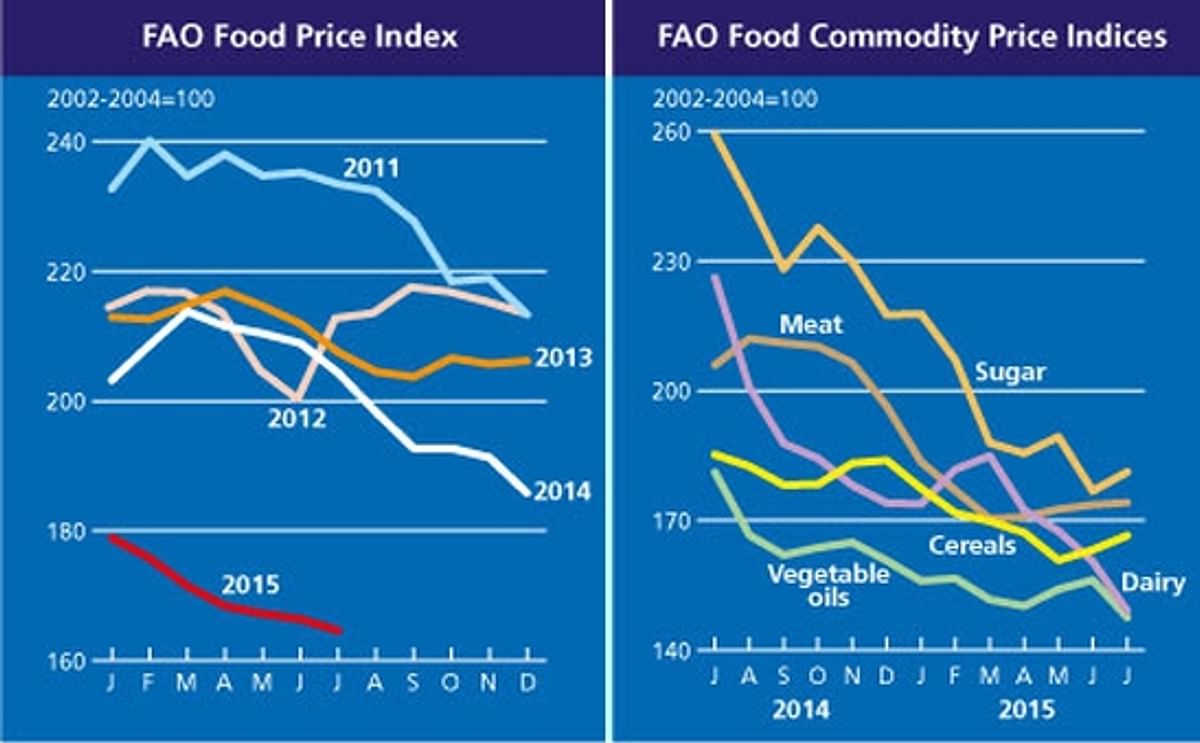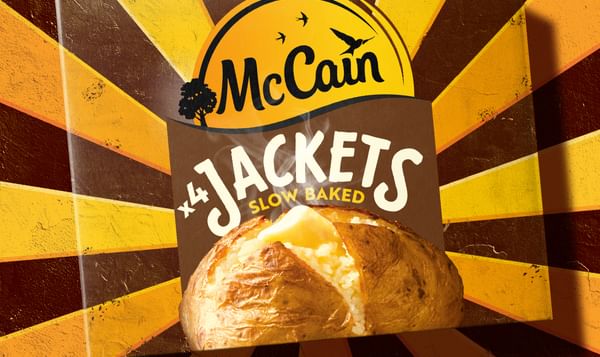The FAO Food Price Index (left) and the FAO Food Commodity Price Indices (right) up to July, 2015 (release date 2015/08/06)
FAO Food Price Index at six year low

The FAO Food Price Index averaged 164.6 points in July 2015, down 1.7 points (1.0 percent) from June and almost 40 points (19.4 percent) less than in July 2014. At its current level, the Index has reached its lowest monthly value since September 2009. Last month’s decline reflected sharp drops in the prices of dairy products and vegetable oils, which more than offset some increases in the prices of sugar and cereals. Meat prices held steady.
The FAO Cereal Price Index averaged 166.5 points in July, up 3.3 points (2.0 percent) from June, but still 18.7 points (10.1 percent) below July last year. For the second consecutive month, strong wheat and maize quotations kept the cereal index rising, while rice prices fell. Unfavourable weather in North America and Europe caused a surge in international prices of wheat and major coarse grains during the first half of July, much of which was eroded in the second half as weather prospects improved. Rice prices remained on a falling trend, reflecting intense exporter competition for markets amid weak import demand.
The FAO Vegetable Oil Price Index averaged 147.6 points in July, nearly 9 points (5.5 percent) below June and its lowest value since July 2009. The recent slide was primarily driven by developments in the palm and soy oil markets. International palm oil quotations eased on increased production in Southeast Asia, combined with slower exports, especially from Malaysia. Soy oil prices weakened further, on ample export availabilities in South America and a favourable outlook for global supply in 2015/16. Continued weakness in crude oil prices also weighed on the vegetable oil complex.
The FAO Dairy Price Index averaged 149.1 points in July, down 11.5 points (7.2 percent) from June. Prices for dairy commodities declined across the board, with milk powders being most affected, followed by cheese and butter. Subdued import demand from China, the Middle East and North Africa caused prices to fall. Additionally, some manufacturers in New Zealand reduced prices in an attempt to trim inventories prior to the closure of the financial year, at the end of July. EU milk production is currently running above its level of a year ago, resulting in good availability of products for export.
The FAO Meat Price Index averaged 174.1 points in July, nearly unchanged from June. International prices of bovine meat moved up, offsetting a decline for pigmeat and ovine meat, while poultry quotations remained stable. Prices of beef from Australia, in particular, rose, supported by stronger import demand from the United States, Japan and the Republic of Korea, amongst others. Muted domestic demand for pigmeat in some EU member states caused quotations to fall, with export prices following suit.
The FAO Sugar Price Index averaged 181.2 points in July, up 4.4 points (2.5 percent) from June 2015. The increase was largely due to reports of less than ideal harvesting conditions in the main sugar producing region of Brazil. Also, so far into the season, a large share of the Brazilian sugarcane harvest is reportedly being diverted for the production of ethanol instead of sugar. The recent gain in sugar prices was contained by a slide in the Brazilian currency against the US dollar, together with expectations of ample supplies in the main sugar producing and exporting regions.
The FAO Cereal Price Index averaged 166.5 points in July, up 3.3 points (2.0 percent) from June, but still 18.7 points (10.1 percent) below July last year. For the second consecutive month, strong wheat and maize quotations kept the cereal index rising, while rice prices fell. Unfavourable weather in North America and Europe caused a surge in international prices of wheat and major coarse grains during the first half of July, much of which was eroded in the second half as weather prospects improved. Rice prices remained on a falling trend, reflecting intense exporter competition for markets amid weak import demand.
The FAO Vegetable Oil Price Index averaged 147.6 points in July, nearly 9 points (5.5 percent) below June and its lowest value since July 2009. The recent slide was primarily driven by developments in the palm and soy oil markets. International palm oil quotations eased on increased production in Southeast Asia, combined with slower exports, especially from Malaysia. Soy oil prices weakened further, on ample export availabilities in South America and a favourable outlook for global supply in 2015/16. Continued weakness in crude oil prices also weighed on the vegetable oil complex.
The FAO Dairy Price Index averaged 149.1 points in July, down 11.5 points (7.2 percent) from June. Prices for dairy commodities declined across the board, with milk powders being most affected, followed by cheese and butter. Subdued import demand from China, the Middle East and North Africa caused prices to fall. Additionally, some manufacturers in New Zealand reduced prices in an attempt to trim inventories prior to the closure of the financial year, at the end of July. EU milk production is currently running above its level of a year ago, resulting in good availability of products for export.
The FAO Meat Price Index averaged 174.1 points in July, nearly unchanged from June. International prices of bovine meat moved up, offsetting a decline for pigmeat and ovine meat, while poultry quotations remained stable. Prices of beef from Australia, in particular, rose, supported by stronger import demand from the United States, Japan and the Republic of Korea, amongst others. Muted domestic demand for pigmeat in some EU member states caused quotations to fall, with export prices following suit.
The FAO Sugar Price Index averaged 181.2 points in July, up 4.4 points (2.5 percent) from June 2015. The increase was largely due to reports of less than ideal harvesting conditions in the main sugar producing region of Brazil. Also, so far into the season, a large share of the Brazilian sugarcane harvest is reportedly being diverted for the production of ethanol instead of sugar. The recent gain in sugar prices was contained by a slide in the Brazilian currency against the US dollar, together with expectations of ample supplies in the main sugar producing and exporting regions.
Like to receive news like this by email? Join and Subscribe!
Join Our Telegram Channel for regular updates!
Sponsored Content
Sponsored Content
Sponsored Content
Sponsored Content
Sponsored Content










